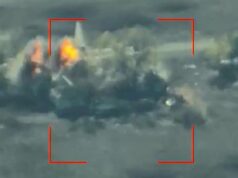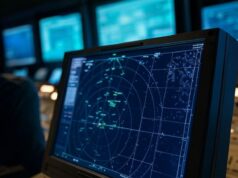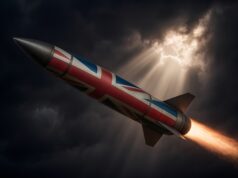The Airborne Warning and Control System (AWACS) capability provided by the RAF’s E-3D Sentry fleet has been allowed to decline.
The 2015 SDSR committed the RAF to keeping the fleet in service until 2035, but the E-3D aircraft are no longer maintained and upgraded to the required avionics standards, and flying hours in recent years have been substantially reduced say the Defence Committee.
AWACS provide airborne surveillance and battle management capability over extended range, crucial in a complex airspace contested by peer adversaries. Recent reports indicate that a replacement for Sentry is being considered as part of the MDP.
The report says that the full range of available options including (but not confined to) an upgrade of the E-3D Sentry aircraft, should be considered by the RAF to restore its AWACS capability.
The Ministry of Defence’s Modernising Defence Programme (MDP) must address the challenges presented by the resurgence of state-based threats and be supported by a fully-funded and sustainable financial settlement, says a report published by the Defence Committee. The report, entitled Beyond 2 per cent, has been produced ahead of the anticipated release of ‘high-level findings’ by the MDP, towards the end of June. It examines how the process has proceeded and highlights areas, including capability, commercial practices, recruitment and international partnerships, which the Committee expects the review to consider.
Options for the future delivery of the UK’s Airborne Warning and Control capability are being explored, with the focus now on replacing the E-3D Sentry fleet. We understand that upgrades however are reportedly considered to be expensive. According to Janes here, maintenance is becoming increasingly costly and replacing them instead might be the most cost-effective option.
Guto Bebb, Parliamentary Under-Secretary of State for Defence, recently said:
“No decision has been made with regard to the future delivery of the UK’s Airborne Warning and Control capabilities, although a range of options are being explored.”
Some industry commentators are also arguing for a new aircraft type altogether. The large sums of money allocated to upgrading the E-3D fleet should be used to purchase a more advanced off-the-shelf aircraft, a defence analyst has argued. Justin Bronk, Research Fellow, Airpower and Technology, outlines options for replacing the E-3 fleet in his paper ‘The Future of Air C2 and AEW: E-3 Sentry, Threat Technologies and Future Replacement Options’:
“The RAF’s E-3Ds need a £2-billion CSP both to bring them to rough parity with current US and French standards by the mid-2020s and to stretch the fleet out to 2035 in the process. However, the E-3, even in modernised form, is no longer a cutting-edge ABM&S system in a world where proliferating long-range missile systems and emerging non-Western low-observable fighters can force it to stay hundreds of kilometres from contested airspace, placing a higher premium on BLOS communications capacity rather than onboard sensors.
Even when it is able to operate closer to the battlespace, the AN/APY-1/2 mechanically scanned radar array common to all E-3s has significant inherent limitations in terms of its ability to detect low-observable, very slow moving and hypersonic threats, unlike more modern AESA-equipped AWACS types already in service with the US Navy and various air forces around the world. An AESA-equipped ABM&S platform with improved communications node capabilities, based on a commercial-derivative airframe, seems a logical alternative option which could provide the RAF with a more capable and efficient alternative to extending the life of the E-3D over the next 20 years.
Such an approach would incur programmatic risk and acquisition and integration costs, but the MoD should examine and weigh these against the expensive work required to extend the E-3D with a view to ensuring the RAF has the best capability possible for the next two decades.”
The US designed E-3D Sentry AEW.Mk 1 is an airborne early warning (AEW) and command and control aircraft in British service, but what does that mean?
The Sentry monitors airspace to provide threat detection of adversary aircraft and situational awareness on friendly assets.
Information gathered by the Northrop Grumman APY-2 radar is processed by the mission crew and disseminated via a variety of data links and communication systems. Sentry also has the capability to detect ships, relaying information to maritime aircraft or allied vessels for further investigation. Its electronic support measures equipment enables the E-3D to gather emissions from other radar systems and emitters, enhancing the crew’s understanding of the environment in which it is operating.














US Navy E-2D, with all the R&D, interoperability-proving and de-risking done is a no-brainer: that means that MOD Procurement will apply ‘no brains’ and string out the acquisition for all the procurement ‘process’ they can generate. Lin-16/MIDS-capable, it will be instantaneously interoperable with Typhoon, F-35 and RIVET JOINT and with a smaller crew due to higher automation. Instead, EU-leaning MOD Procurement aparatchiks will want to RFI for a largely non-existent European Defense Initiative alternative which will be full of risk with lots of lovely pointless R&D for DSTL. There’s my 10 Cents.
JMC I agree, the E2-D has better over water performance than the current E3 models as I understand it. In addition it come with the same air to air refueling setup used by the RAF
E-2D would be bonkers.
The real no-brainer is the E-7 Wedgetail. More capable than E-2D and with commonality with the P-8 Poseidon fleet that we’re buying.
the word’decline’ is a word too often used in the area of defence reporting.
Yes a “no-brainer”, and in it’s laughable even thinking the RAF should buy the little Hawkeye. All of what R&D, exactly?
I wonder how many other assets across the forces have been managed likewise?
I wonder if we could operate E2D in a STOBAR configuration off of the QE class?
Unfortunately no.
Does not E-7 wedgetail come into the picture? already in service elsewhere- The Times today reported a row about a possible purchase of E-7.
E7 is the obvious choice for the RAF. Upgrading and refurbishing the E3 is a complete waste of money.
Available to order now and a very capable asset.
When you see E3’s at RAF Waddington being dismantled for parts you knew things have gone too far. Can’t we for once co-operate with Japan or another country to have something other than Boeing? Let’s have a bit of competition so we’re not paying for something with no UK content.
DOn’t blame Boeing for the decline in the serviceability of the E-3D fleet; it was Northrop Grumman who promised to maintain and improve airframe availability when the competition to provide Whole Life Support was run in 2004/5. A key element, the role of the Design Authority, placed NG on a par with Boeing in the role of Design Authority. Access to Boeing data such as wind tunnel data, airframe fatigue analysis and electrical loads analysis was supposed to be contracted for with Boeing providing access on a rolling contract. NG decided not to do that, claiming the Boeing price was too high and that it wasn’t budgeted for. They “won” the competition on false pretenses and availability has declined almost every year since the 2005 contract award.
“Allowed to decline” by being on par with the USAF’s new E-3G, an upgrade of their standard E-3Bs that the UK’s E-3D already was? Flying hours aren’t reduced and there aren’t any of them being dismantled (?), despite a bizarre comment on here.
“The RAF’s E-3Ds need a £2-billion CSP both to bring them to rough parity with current US and French standards”
They already are; wouldn’t thought Justin would know what he’s talking about, or is this MIC clamouring for even more spending?
I wonder, we have had the announcement that we are to get 7 E-7 Wedgetail yet the question is, is that enough?
If they are used just for the UK and N.Europe then yes, if for the UKs world wide resposibilities then No.
Possibly we could have a two tier AWACS system, this depends on how much we are stripping out of our current E3-Ds to keep others flying.
The idea is this use the E7s for frontline service with the RAF fighter squadrons etc, strip out the missions package of the E3-D up grade them possibly to F and install them in second hand Airbus A330s. A second hand A330 is about £40 million so 5-7 will cost the same as a two new B767s. I would imagine that a used 767 would cost about the same. With a bulk buy, of 10year old or less aircraft we could get them for £200-£250million. Japan is installing the E3 package into a B767 and the Mod in 2015 was thinkinh atone point to keep the E3-D until 2035. So the issue does not appear to be the missions package but the airframe, which is understandable its a 707. If the UK was to use the used 767 idea then they could copy the Japanese in how they did it, I even think Japan would help. Then comes the convertion work why not let the RAF technicians loose, bring in specilist support from Lockheed Martin and Beoing but the RAF techies are more than capable to do the job.
It would mean for about £350 million we could have a further 5-7 AWACS that can be used as a back up to the RAF but to be used primerily in UK waters survailance, maybe two based in the Caribbean for anti drug patrols, possibly Cyprus or even the Falkalnds. This would leave the E7s as front line AWACS and a new airframed E3-D+ as guard duty. They would lack air to air refueling, but in fishery patrol, anti drug operations and areas such as the Falklands where the liklyhood of dealing with stealth combt aircraft is highly unlikly then
they would be a good backup and trip wire. It will also save E7 airframe time so saving money in the long run.